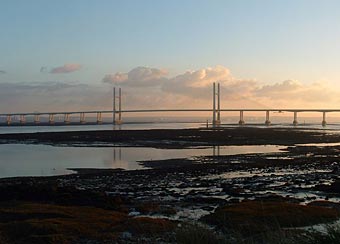Town History
Caldicot Castle's well preserved fortifications were founded by the Norman's and fully developed, in royal hands, by the late 14th century.
Restored as a family home by a wealthy Victorian, the castle offers the chance to explore medieval walls and towers in a setting of tranquil gardens and wooded Country Park.
Caldicot has its roots in the past with its wonderful old castle built by the Norman's 900 years later the French built a stupendous new road bridge crossing the river Severn which now makes Caldicot the new gateway into Wales (second Severn Bridge opened 1996).
During the first half of the 20th century Caldicot continued to grow steadily, but unspectacularly, reaching a population of 1,770 in 1951. Early in the 1950's, however, Chepstow Rural District Council decided that the village should be allowed to expand to approximately 3,000. Shortly after this decision, the government decided to build a new steelworks at Llanwern. Caldicot was designated as a suitable home for the thousands of steelworkers. Expansion plans were revised upwards. Llanwern steelworks opened in 1962 and by the end of the decade Caldicot was occupied by over 7,000 people and was still growing. The village was fast becoming a town.
The growth of the community was furthered by the opening of the Severn Bridge in 1966, strengthening the ties between Caldicot and the Bristol region which have always been so important to the wellbeing of the area.
With Caldicot now being part of the 'M4 Corridor' new industries such as Mitel Telecom came to the town, compensating for the contraction of the steel industry and the railways.
With the construction of the Second Severn Crossing, Caldicot appears to be destined to continue its growth.
In earlier years growth was achieved at the expense of the destruction of some of Caldicot's historic buildings. It is to be hoped that future development will take place in a more enlightened way, remembering that Caldicot has a proud past as well as a bright future.
Hanes y Dref
Cafodd amddiffynfeydd cadarn castell Cil-y-coed eu sefydlu gan y Normaniaid ac roeddent wedi eu datblygu’n llawn, mewn dwylo brenhinol, erbyn diwedd y 14eg ganrif.
Wedi’i adfer fel cartref gan deulu cyfoethog yn oes Victoria, mae’r castell yn cynnig cyfle i ymchwilio muriau a thyrrau canoloesol mewn gosodiad o erddi heddychlon a Pharc Gwledig coediog.
Mae gwreiddiau Cil-y-coed yn y gorffennol gyda’i hen gastell gwych a adeiladwyd gan y Normaniaid. 900 mlynedd yn ddiweddarach adeiladodd y Ffrancwyr bont ffordd newydd ysblennnydd yn croesi’r afon Hafren sy’n awr yn gwneud Cil-y-coed y porth newydd i Gymru (agorodd Ail Groesfan yr Hafren yn 1996).
Yn ystod hanner cyntaf y 20fed ganrif parhaodd Cil-y-coed i dyfu’n raddol gan gyrraedd poblogaeth o 1,770 yn 1951. Ddechrau’r 1950au, fodd bynnag, penderfynodd Cyngor Dosbarth Gwledig Cas-gwent y dylid caniatáu i’r pentref ehangu i tua 3,000. Yn fuan ar ôl y penderfyniad hwn, penderfynodd y llywodraeth adeiladu gwaith dur newydd yn Llanwern. Dynodwyd Cil-y-coed yn gartref addas ar gyfer y miloedd o weithwyr dur. Cafodd cynlluniau ehangu eu cynyddu. Agorodd gwaith dur Llanwern yn 1962 ac erbyn diwedd y degawd, roedd dros 7,000 o bobl yn byw yng Nghil-y-coed ac roedd yn dal i dyfu. Roedd y pentref yn gyflym yn dod yn dref.

Cafodd twf y gymuned ei hybu ymhellach gan agor Pont Hafren yn 1996, gan gryfhau’r cysylltiadau rhwng Cil-y-coed ac ardal Bryste a fu bob amser mor bwysig i les yr ardal.
Gyda Cil-y-coed bellach yn rhan o ‘Goridor yr M4’, daeth diwydiannau newydd tebyg i Mitel Telecom i’r dref, gan lenwi bwlch yn dilyn y crebachu yn y diwydiant dur a’r rheilffyrdd. Gyda chodi Ail Groesfan yr Hafren, mae’n ymddangos y bydd twf Cil-y-coed yn parhau.
Mewn blynyddoedd blaenorol sicrhawyd twf ar draul dinistrio rhai o adeiladau hanesyddol Cil-y-coed. Gobeithir y bydd datblygiad y dyfodol yn digwydd mewn ffordd fwy goleuedig, gan gofio fod gan Gil-y-coed orffennol balch yn ogystal â dyfodol disglair.